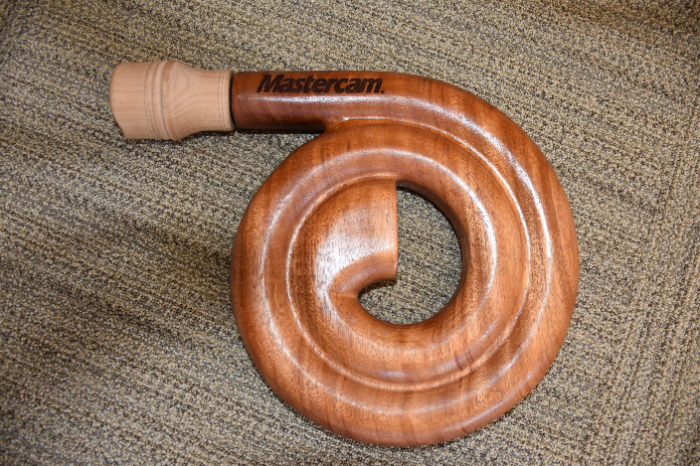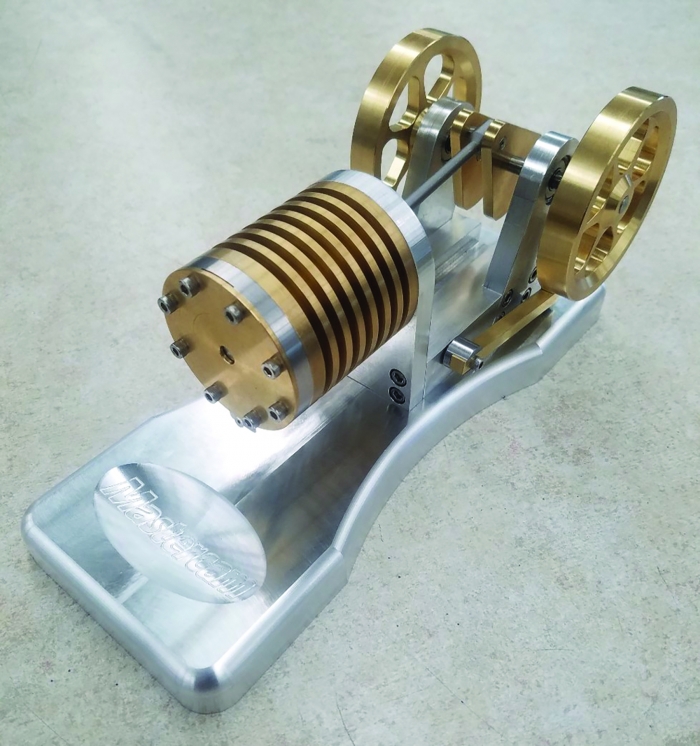CNC Software Inc. has announced the winners of the 2017-2018 Wildest Parts competition. The company develops the industry leading CAD/CAM software, Mastercam, and holds the Wildest Parts Competition each year to encourage student interest and participation in manufacturing. The competition is open to students at the secondary and postsecondary levels to create parts demonstrating creativity and technical skill using Mastercam.
In the Secondary Division, Caelen DeVall from Hamilton High School submitted a spiral didgeridoo, which is a large wind instrument, typically from 1 to 2 meters in length (which is long and hard to transport). DeVall plays the didgeridoo and owns one, but he wanted a more compact instrument to bring around with him. So, his idea was to design a more efficiently spaced didgeridoo that has been wrapped to fit into a smaller space and function as an instrument. He applied Mastercam’s Dynamic OptiRough toolpath for the inside of the instrument and applied both rough and finish toolpaths for the outside. Grayson Weber from Capital High School placed 2nd with a fly tying kit, and Zane King from Capital High School placed 3rd with his submission of dirt bike pegs.

Caelen DeVall, a student at Hamilton High School, won 1st place in the secondary division for producing this spiral didgeridoo. His instructor is Brent Holmes.
In the Postsecondary Division, Andrew Nicosia from Erie Community College submitted a vacuum engine. He wanted to challenge himself with a complex machining project for his Advanced CNC class. The engine is designed to run off a butane or propane torch held in front of the small hole in the top of the cylinder. There are 24 different parts in this assembly, and a total of 32 mill programs and five lathe programs to create the engine. Nicosia learned how to push the machine and cutting tools to their limits in Mastercam and noted that Mastercam took his abilities to a whole other level and showed him what he is truly capable of making. Sam Galliart from Pittsburg State University placed 2nd with a gorilla face injection mold.

Every participant receives a Mastercam t-shirt, and the winning students receive cash awards while their instructors are given shirts, plaques and other prizes for encouraging their students to enter. The Gene Haas Foundation provided support for the Wildest Parts Competition. The Gene Haas Foundation also awards scholarships for continuing education: $1,500 for 1st place, $750 for 2nd place and $250 for 3rd place.
Even as this year’s winners are announced, it’s time for teachers and students to start thinking about what they will submit for the 2019 Wildest Parts Competition. Submissions must be received before the June 28 deadline.
Related Glossary Terms
- computer numerical control ( CNC)
computer numerical control ( CNC)
Microprocessor-based controller dedicated to a machine tool that permits the creation or modification of parts. Programmed numerical control activates the machine’s servos and spindle drives and controls the various machining operations. See DNC, direct numerical control; NC, numerical control.
- lathe
lathe
Turning machine capable of sawing, milling, grinding, gear-cutting, drilling, reaming, boring, threading, facing, chamfering, grooving, knurling, spinning, parting, necking, taper-cutting, and cam- and eccentric-cutting, as well as step- and straight-turning. Comes in a variety of forms, ranging from manual to semiautomatic to fully automatic, with major types being engine lathes, turning and contouring lathes, turret lathes and numerical-control lathes. The engine lathe consists of a headstock and spindle, tailstock, bed, carriage (complete with apron) and cross slides. Features include gear- (speed) and feed-selector levers, toolpost, compound rest, lead screw and reversing lead screw, threading dial and rapid-traverse lever. Special lathe types include through-the-spindle, camshaft and crankshaft, brake drum and rotor, spinning and gun-barrel machines. Toolroom and bench lathes are used for precision work; the former for tool-and-die work and similar tasks, the latter for small workpieces (instruments, watches), normally without a power feed. Models are typically designated according to their “swing,” or the largest-diameter workpiece that can be rotated; bed length, or the distance between centers; and horsepower generated. See turning machine.
- milling machine ( mill)
milling machine ( mill)
Runs endmills and arbor-mounted milling cutters. Features include a head with a spindle that drives the cutters; a column, knee and table that provide motion in the three Cartesian axes; and a base that supports the components and houses the cutting-fluid pump and reservoir. The work is mounted on the table and fed into the rotating cutter or endmill to accomplish the milling steps; vertical milling machines also feed endmills into the work by means of a spindle-mounted quill. Models range from small manual machines to big bed-type and duplex mills. All take one of three basic forms: vertical, horizontal or convertible horizontal/vertical. Vertical machines may be knee-type (the table is mounted on a knee that can be elevated) or bed-type (the table is securely supported and only moves horizontally). In general, horizontal machines are bigger and more powerful, while vertical machines are lighter but more versatile and easier to set up and operate.
- toolpath( cutter path)
toolpath( cutter path)
2-D or 3-D path generated by program code or a CAM system and followed by tool when machining a part.
